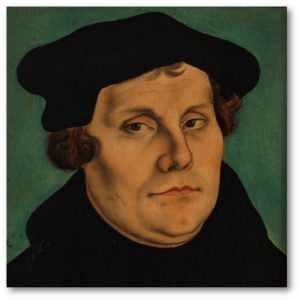
Reformation
Reformation
Duluth Superior Symphony Orchestra
November 18th 2017 @ 7pm
DECC Symphony Hall, Duluth, MN
Mendelssohn: Symphony No.5, Reformation
Brahms: A German Requiem
DSSO Chorus
TBA, soprano
Andrew Wilkowske, baritone
Luther’s Reformation
When Johannes Gutenberg invented the first printing press in the 15th century, little did he know how his invention would change the world. The ability to mass-produce books made knowledge available on a much broader scale and soon this resulted in significant social changes. The blossoming of the arts, literature and sciences during the Renaissance was in no small part made possible by Gutenberg’s invention.
In the spirit of the Renaissance people began to ask questions – even in areas that were previously taboo. Martin Luther was one of those who liked to ask questions. As professor for Theology, Luther disagreed with many practices of the Catholic Church, especially the practice of selling plenary indulgences, certificates sold by priests to reduce punishment for our sins in the afterlife. On October 31st 1517 Martin Luther published his Ninety-Five-Theses, arguing against such practices and promoting true spiritual repentance, by nailing the document on the door of the All-Saints Church in Wittenberg. Today, this date is considered the start of the Reformation, the movement that would change the face of Europe and spilt Christianity in Catholicism and Protestantism.
After years of refusing to denounce his writings, Luther was finally excommunicated in 1521. But defiant till the end, he published his own translation of the Holy Bible in 1534. Thanks to the advance of book printing less than 100 years prior, the Luther Bible quickly became widely known and helped spread the new branch of Christianity, called Lutheranism. It was this Luther Bible that Johannes Brahms would pick up 300 years later, to derive from it the texts for his German Requiem.
Brahms: A German Requiem
Brahms’ inspiration to write a requiem is not entirely clear. But many suspect that two events in his life might have motivated him to write a mass for the dead: the death of his mother in 1865, and the traumatic events his friend and mentor Robert Schumann went through several years prior. Schumann had not just helped the young Brahms to break onto the scene as a composer of promise. He had publicly proclaimed that Brahms was the true heir of Beethoven’s legacy. So when Schumann attempted suicide in 1854, Brahms moved to Düsseldorf to help Schumann’s wife, Clara, support her sick husband, who had voluntarily checked himself into a mental institution. Brahms developed a deep love towards Clara, which complicated his emotional attitude towards his sick mentor even further. Schumann died two years later.
Brahms first referred to his work as Ein Deutsches Requiem (A German Requiem) in a letter to Clara Schumann in 1865. The work is written for orchestra, chorus, baritone and soprano solo. Brahms had assembled the libretto himself, deriving the texts from the German Luther Bible. Even though he was protestant himself, he was not a very religious person and his requiem avoids any Christian dogma, which are usually associated with the classical requiem. Instead it presents a more worldly and inclusive perspective and Brahms once pointed out that he would have liked to call the work “A Human Requiem”.
Mendelssohn: Reformation Symphony
We are celebrating 500 years of Reformation in 2017, and many years prior Felix Mendelssohn ceased a similar occasion to write his Reformation Symphony. His Symphony No.5 was written to commemorate the 300th anniversary of the Presentation of the Augsburg Confession, a key document of Lutheranism. Like most of his works, the symphony is abundant with memorable melodies and brilliant orchestral writing. Mendelssohn based the Finale of his work on Martin Luther’s chorale A Mighty Fortress Is Our God. (Luther was also a prolific hymnodist, creating the texts and melodies to countless chorales.) Mendelssohn’s symphony ends with the orchestra stating Luther’s powerful melody with full force.
This video is set to start at the grand chorale at the end. But of course you can go back to enjoy the entire symphony.
[:]


